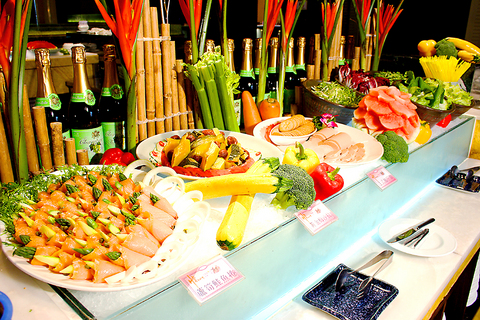Buffet restaurants are a common part of the landscape in Taipei offering Japanese, Chinese and Western fare. Rarely does a restaurant incorporate food from so many different cultures into one gluttonous whole like Splendor Restaurant, which is conveniently located three minutes walk, or a longer waddle after dining, from Dapinglin (大坪林) MRT station.
The dining area is large with the buffet taking up one-quarter of the restaurant. The decor is minimalist with black marble walls, white marble tabletops and black rubber chairs that hug the body. The designers of the restaurant clearly understood the distraction that a wide variety of food causes diners, and as a result there is plenty of space to move about when going up for a fourth or fifth helping.
Hip hostess Tseng Yue-li (曾月裡) makes it clear that eating at Splendor should be a total dining experience, not just an excuse to expand your waistline. As such, she recommends trying a variety of dishes before gorging on any one dish from a particular region.

PHOTO COURTESY OF SPLENDOR RESTAURANT
If you are a lover of seafood, the Japanese section has many surprises. In addition to the usual suspects of sashimi, tempura and a variety of hot pot dishes, there are a variety of fresh seafood salads on offer. But what separates this Japanese-themed section from its counterparts is its large assortment of freshly caught fish laid out on a bed of ice or swimming in large tanks.
The wide range of Cantonese cuisine, especially the dim sum, is particularly worthy of mention. With such an array to choose from, it's best to tuck in when the place is busy as eating dumplings that have been sitting for 15 or more minutes is not recommended.
For those who are not afraid of a little protein, prime rib and cooked ham are available. Carved before your eyes, both are cooked to perfection and will be sliced thin or thick, according to your appetite. There is also bratwurst, barbecued mushrooms and a variety of other meats.
Rounding out the meal, if you can fit it in, are eight varieties of Haagen-Dazs ice cream and a staggering variety of desserts, though on this last score I cannot comment, as I was too busy with the ice cream. The restaurant offers bottomless beer and red and white wine. The Taipei Times reminds patrons to drink responsibly.

April 28 to May 4 During the Japanese colonial era, a city’s “first” high school typically served Japanese students, while Taiwanese attended the “second” high school. Only in Taichung was this reversed. That’s because when Taichung First High School opened its doors on May 1, 1915 to serve Taiwanese students who were previously barred from secondary education, it was the only high school in town. Former principal Hideo Azukisawa threatened to quit when the government in 1922 attempted to transfer the “first” designation to a new local high school for Japanese students, leading to this unusual situation. Prior to the Taichung First

When the South Vietnamese capital of Saigon fell to the North Vietnamese forces 50 years ago this week, it prompted a mass exodus of some 2 million people — hundreds of thousands fleeing perilously on small boats across open water to escape the communist regime. Many ultimately settled in Southern California’s Orange County in an area now known as “Little Saigon,” not far from Marine Corps Base Camp Pendleton, where the first refugees were airlifted upon reaching the US. The diaspora now also has significant populations in Virginia, Texas and Washington state, as well as in countries including France and Australia.

On April 17, Chinese Nationalist Party (KMT) Chairman Eric Chu (朱立倫) launched a bold campaign to revive and revitalize the KMT base by calling for an impromptu rally at the Taipei prosecutor’s offices to protest recent arrests of KMT recall campaigners over allegations of forgery and fraud involving signatures of dead voters. The protest had no time to apply for permits and was illegal, but that played into the sense of opposition grievance at alleged weaponization of the judiciary by the Democratic Progressive Party (DPP) to “annihilate” the opposition parties. Blamed for faltering recall campaigns and faced with a KMT chair

Article 2 of the Additional Articles of the Constitution of the Republic of China (中華民國憲法增修條文) stipulates that upon a vote of no confidence in the premier, the president can dissolve the legislature within 10 days. If the legislature is dissolved, a new legislative election must be held within 60 days, and the legislators’ terms will then be reckoned from that election. Two weeks ago Taipei Mayor Chiang Wan-an (蔣萬安) of the Chinese Nationalist Party (KMT) proposed that the legislature hold a vote of no confidence in the premier and dare the president to dissolve the legislature. The legislature is currently controlled